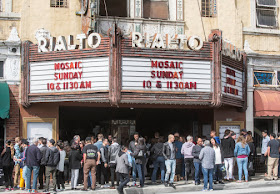I knew there were good reasons why I hated the movie, I just didn't know there were so many
From a Bright Lights Film Journal essay by Richard A. Voeltz, titled “The Joke’s on History”: Retro-Reality, Twee, and Mediated Nostalgia in La La Land (2016):
"La La Land is more of a composite remake; even better, an archive, where Chazelle cleverly uses a combination of parody, homage, and nostalgia to continue, remake, and reimagine nostalgic themes or franchises established in earlier times that places it in the epistemological category of the nostalgic remake as defined by Lizardi that blocks engagement with the past or present.... “La La Land ultimately feels bloated by its references, by the mad rush to imitate all Chazelle’s inspirations,” writes Christos Tsiolkas.
"The movie opens with the old CinemaScope logo in a similar way that Quentin Tarantino pays homage to the movies that he is imitating. The shooting of the film in CinemaScope is important because “the technique represented a groundbreaking new widescreen process that revolutionized filmmaking in the 1950s,” which explains why aesthetically the film manages to look like a classic movie-musical even when it’s just panning across a modern-day traffic jam at the beginning of the film.25 This is a film that draws on classic musicals and films that most people would only know from watching TCM religiously: Singin’ in the Rain (1952), Top Hat (1935), Shall We Dance (1937), The Band Wagon (1953), Broadway Melody (1936), An American in Paris (1951), An Affair to Remember (1957), West Side Story (1961), Bogie Nights (1997), Funny Face (1957), Moulin Rouge (2001), and Sweet Charity (1969) among many others. Sara Preciado has, in fact, compiled a YouTube video comparing scenes from La La Land with ones from these famous musicals.26 Rebel Without a Cause (1955) also plays a significant role in the film. Even Annie Hall (1977), Pulp Fiction (1994), and 8 ½ (1963) make the list. But none resonate as much as Jacques Demy’s The Umbrellas of Cherbourg (1964) and his lesser-known The Young Girls of Rochefort (1967). Demy’s Umbrellas provides not only inspiration for the plot, ending, along with the 1927 silent film 7th Heaven, and music of La La Land, but also for Chazelle’s use of vibrant colors of blue, red, green, and yellow in the cinematography."
Also
"Sebastian drives a 1982 Buick Riviera convertible and listens to music on a tape deck. He plays vinyl jazz records at home. And the needle-scraping ending of such records figures prominently as a metaphor for his relationship with Mia winding down as well. Early in the movie, a dinner conversation between Mia’s then boyfriend Greg, his brother, and his wife deals with the subject of “nowadays theatres … they’re so dirty – and they’re either too hot or too cold – always people talking.” When Mia and Sebastian meet at the vintage Rialto* theatre in Pasadena, later shown as closed (Chazelle loved the old red velvet seats), to see Rebel Without a Cause, the celluloid film during the scene of the drive up to the Griffith Park Observatory melts in the projector. This is a retro-intertextual reminder of when the film burns in the middle of Ingmar Bergman’s Persona (1966)"
Yeah it's just pure pastiche puke from start to finish... meta upon meta... and these quotes are just a fraction of Voeltz's inventory of the ways in which La La sucks
But the other thing, though - the real failing is on a much more basic level. It harks back to a golden age of song and dance movies, but the dancing is not very good and the songs aren't much cop either. If you're going to resurrect the lost golden age then you have to compete with Singin' in the Rain, High Society and West Side Story, on the toon and tap front...
* that Rialto Theatre is just up the road from us in South Pas.. was where a crucial scene from The Player was filmed (so that layers even more retro-referentialism)... was a ghost cinema for a long while... has recently been refurbished, but not to show pictures: on Sundays it hosts the "hipster church" Mosaic


This comment has been removed by the author.
ReplyDeleteIs that for real? Hipster church?
ReplyDeleteThe hipster church history might be slightly interesting actually.
Five years after Persona the celluloid also melts in Two Lane Blacktop. In Hellmann's movie though it's at the end of the film, actually how the film ends.
ReplyDelete